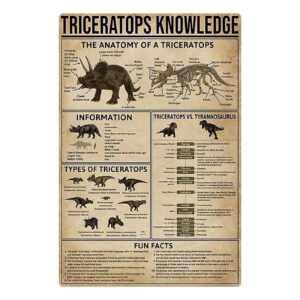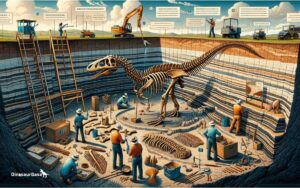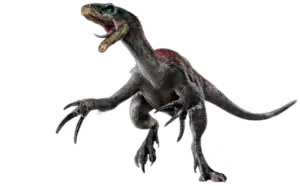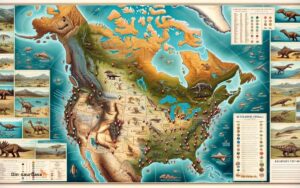What Did Achelousaurus Eat in the Late Cretaceous?
Achelousaurus, a herbivorous dinosaur, fed on plants during the Late Cretaceous period. Its diet likely included ferns, conifers, and angiosperms.
Achelousaurus roamed North America about 74 to 70 million years ago, sharing the landscape with a diversity of plant life that sustained its herbivorous lifestyle.
Named after the Greek river deity Achelous, this dinosaur possessed a distinctive skull with prominent horns and a bony frill—a feature it may have used for defense or display.
Scientists infer its diet based on the ecological context and dental morphology, suggesting a preference for the abundant vegetation of its era.
With strong, chisel-like teeth, Achelousaurus was well-equipped to munch on the tough foliage of prehistoric times, contributing to the complex ecosystem of the Cretaceous.
Paleontologists continue to study fossils like those of Achelousaurus to better understand the intricate relationships between dinosaurs and their environments.
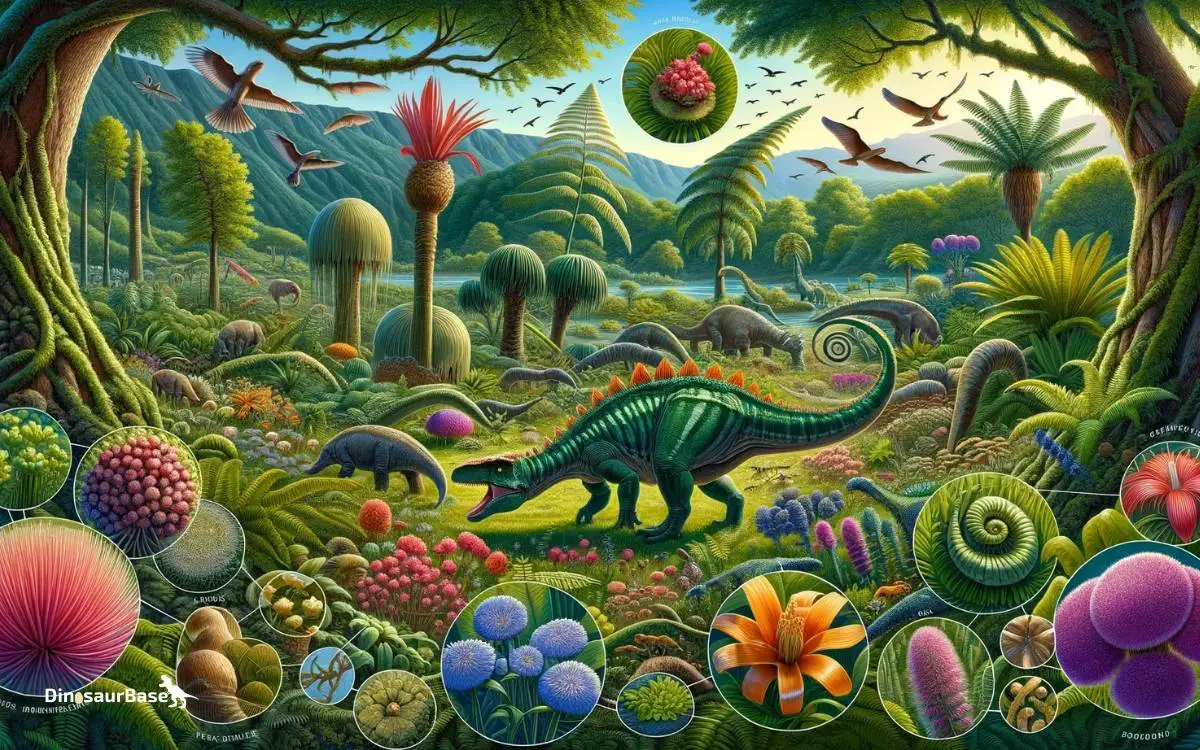
The Late Cretaceous Period
The Late Cretaceous Period marks an era of magnificent dinosaurs roaming Earth. During this time, a diverse ecosystem thrived, setting the stage for incredible creatures like the Achelousaurus.
Achelousaurus Habitat
The Achelousaurus lived in areas that are now North America. Vast floodplains and lush forests provided the perfect home. These habitats had rivers and streams which kept the land fertile.
- Rivers and Floodplains: Water sources supported the vegetation.
- Coniferous Forests: Tall trees were common in the region.
- Open Meadows: These spaces offered ample grazing for herbivores.
Flora And Fauna Of The Era
Plants and Animals in the Late Cretaceous Period were diverse. Different species interacted within this dynamic ecosystem.
| Plant Life | Animal Species |
|---|---|
| Ferns and cycads | Tyrannosaurus Rex |
| Flowering plants (angiosperms) | Triceratops |
| Conifers | Hadrosaurs |
Dinosaurs dominated, while plants like angiosperms revolutionized food sources. Massive predators like the T-Rex hunted in these lands, and the armored Triceratops was a common sight.
Achelousaurus: A Brief Profile
Welcome to a journey back in time to the Late Cretaceous period, an era where the intriguing dinosaur known as Achelousaurus roamed our planet.
In this section, we’ll delve into the world of this enigmatic creature that has captured the imagination of scientists and enthusiasts alike. Discover its physical makeup and where it fits in the grand tapestry of prehistoric life.
Physical Characteristics
The Achelousaurus was a sight to behold with distinctive features setting it apart.
- Size: It measured about 20 feet in length, making it a medium-sized ceratopsian.
- Weight: It tipped the scales at around 3 to 4 tons.
- Skull: The skull featured a large, bony frill and two pairs of horns, but these were not as prominent as those of its relatives.
- Snout: A unique feature was the absence of nasal horns, replaced by rough bosses – bumps of bone.
- Beak: It possessed a strong parrot-like beak, designed to snip vegetation with ease.
These physical traits hint at a life spent browsing on the abundant flora of its habitat.
Taxonomic Classification
Understanding the Achelousaurus‘ taxonomic place sheds light on its evolutionary journey.
| Kingdom | Animalia |
|---|---|
| Phylum | Chordata |
| Class | Reptilia |
| Order | Ornithischia |
| Family | Ceratopsidae |
| Genus | Achelousaurus |
This dinosaur was part of the Ceratopsidae family, renowned for their horned faces and frilled necks.
As part of the genus Achelousaurus, it showcases a fascinating evolutionary link between more primitive and advanced ceratopsians.
Dietary Clues From Fossil Records
Understanding what creatures from the past dined on can be quite the puzzle. But, just like detectives, paleontologists can use clues left in the fossil records to piece together the diet of Achelousaurus, a fascinating dinosaur that roamed in the Late Cretaceous.
Tooth Structure And Function
Teeth tell tales of ancient meals. The teeth of Achelousaurus were not sharp like a carnivore’s. Instead, they were blunt and wide.
These teeth were perfect for grinding and crushing vegetation. Each tooth tells a story of a plant-eating giant.
- Wide Crowns: Suggests large surface area for grinding.
- Wear Patterns: Show leaf stripping and grinding actions.
- Polished Facets: Indicate tough plant material consumption.
Gut Contents And Coprolites Analysis
Another clue comes from the dinosaur’s last meals, preserved in their gut contents or fossilized poop called coprolites. Scientists test these for traces of plants. These tests reveal secrets of the Late Cretaceous menu.
| Analysis Type | Findings |
|---|---|
| Plant Fibers | Indicate leafy diet. |
| Pollen Grains | Suggest flowering plants were eaten. |
| Phytoliths | Show grasses and grains were part of the diet. |
By looking closely at these fossil clues, we unlock the secrets of the Achelousaurus diet. From the teeth adapted for breaking down tough plants to the gut contents showing a variety of vegetation, we can paint a vivid picture of their eating habits, even millions of years later!
The Herbivorous Lifestyle
The Achelousaurus, a remarkable dinosaur of the Late Cretaceous period, lived a life sustained entirely by plants.
This mighty herbivore roamed the earth approximately 74 to 70 million years ago. Its diet consisted of a variety of prehistoric vegetation.
Understanding what these creatures ate helps us piece together the ecological jigsaw of their ancient world.
Preferred Plant Sources
Achelousaurus had a particular taste for certain plants. Scientists have made educated guesses about its diet based on the plant fossils found nearby.
This dinosaur may have preferred:
- Conifers: Towering pine-like trees that were plentiful.
- Cycads: Palm-like plants with fleshy leaves.
- Ferns: Leafy green plants that carpeted the forest floor.
Feeding Strategies And Behaviors
Achelousaurus is believed to have used its unique beak and teeth to feed efficiently. Its feeding mechanics were unlike those of any modern animal. This dinosaur’s behaviors might have included:
| Behavior | Description |
|---|---|
| Low Browsing | Eating plants close to the ground. |
| Selective Feeding | Choosing specific parts of plants. |
| High Browsing | Reaching up to taller trees. |
The skull and horns of Achelousaurus suggest that it was well adapted to its dietary needs. Its lifestyle was one of constant grazing and searching for the best plant materials to consume.
The survival techniques of Achelousaurus showcase the diversity of dinosaur life in the Late Cretaceous period.
Comparative Diets Of Contemporaries
A storm of prehistoric life thundered across the Late Cretaceous landscape, with dinosaurs of all shapes and sizes fighting for survival.
Among them was the notable horned herbivore Achelousaurus. To fully understand its place in the ancient ecosystem, let’s dig into the Comparative Diets of Contemporaries.
Neighboring Herbivores
Feast-filled forests offered ample food for the likes of Achelousaurus and its contemporaries. These herbivorous giants had diets as varied as their appearances. Let’s graze through the menu of their leafy banquets.
- Triceratops: With its three-horned face and mighty frill, it snacked on low-growing plants.
- Edmontosaurus: This duck-billed behemoth browsed for food both on the ground and in trees.
- Ankylosaurus: Armored and squat, it likely munched on ferns and other ground flora.
Predator-prey Dynamics
Looming predators and elusive prey drove the Late Cretaceous food web. Achelousaurus had to balance grazing with staying off the menu.
| Predator | Prey |
|---|---|
| Tyrannosaurus rex | It hunted anything from baby dinos to giants. |
| Dromaeosaurs | These raptors pounced on smaller animals. |
| Albertosaurus | It might have chased after younger, weaker herbivores. |
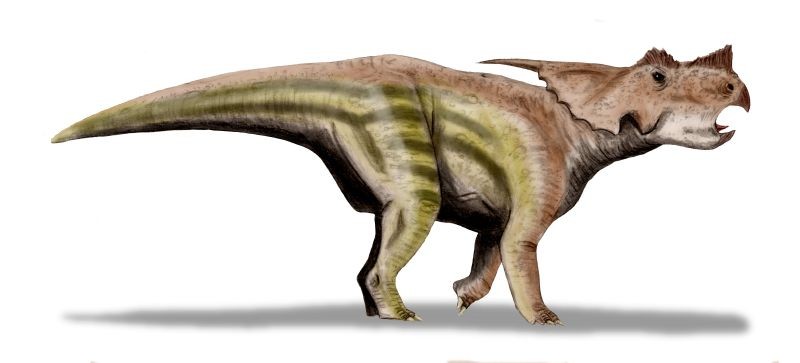
Credit: dinosaurpictures.org
Implications Of Achelousaurus’ Diet
The Implications of Achelousaurus’ Diet reach far beyond its personal eating habits. Understanding what this intriguing dinosaur consumed sheds light on its life and the ecosystem it thrived in during the Late Cretaceous period.
Let’s delve into the role Achelousaurus played in its prehistoric world and how its diet affected its survival against the backdrop of natural selection and environmental change.
Ecosystem Roles
Achelousaurus, a herbivore, was pivotal in maintaining the health of its habitat. It had a significant effect on the flora of the time, shaping the vegetation structure.
Here’s how:
- Seed Dispersal: Consuming plants and traveling across territories, it spread seeds, aiding in the propagation of various plant species.
- Landscape Management: By feeding on specific plants, Achelousaurus helped control plant overgrowth, preventing dominance by a single species.
Extinction Factors And Survival
The diet of Achelousaurus may have influenced its abilities to withstand extinction events. It faced numerous challenges:
| Factor | Effect on Achelousaurus |
|---|---|
| Climate Changes | Shifts in climate could reduce the availability of preferred plants. |
| Competition | Needs to compete with other herbivores for food sources. |
| Resource Scarcity | Scarcity could limit growth and reproductive success. |
Despite these factors, Achelousaurus could have utilized its versatility in plant selection to aid its survival for a time, highlighting its adaptive nature within its ecosystem.
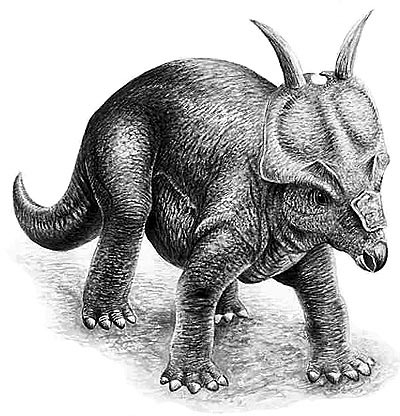
Credit: www.nhm.ac.uk
How Did Achelousaurus’ Unique Skull Shape Affect Its Diet in the Late Cretaceous?
The unique Achelousaurus skull study revealed that its unusual skull shape likely influenced its diet in the Late Cretaceous. With its broad, shovel-like snout, it probably grazed on tough, fibrous vegetation, similar to a modern-day shovel-beaked bird. This adaptation allowed it to thrive in its environment.
Frequently Asked Questions For What Did Achelousaurus Eat In The Late Cretaceous?
Who Found Achelousaurus?
Paleontologist Scott Sampson discovered Achelousaurus in 1987. He made the discovery in Montana, within the Two Medicine Formation.
What Is The Shortest Dinosaur?
The shortest dinosaur known is the Microraptor, which measured around 2. 5 feet in length.
What Did Dryptosaurus Eat?
Dryptosaurus was a carnivorous dinosaur that primarily fed on other prehistoric animals and possibly carrion. Its diet likely included smaller dinosaurs and mammals.
What Kind Of Trees Did Dinosaurs Eat?
Dinosaurs ate various plants, including ferns, cycads, and conifers. Specific species like the Brachiosaurus likely consumed tall coniferous trees.
Conclusion
Exploring the dietary preferences of Achelousaurus has provided a fascinating glimpse into Late Cretaceous ecosystems.
These majestic herbivores likely grazed on ferns, cycads, and conifers, sustaining their massive frames. Their place in ancient food webs underscores the diversity of life millions of years ago.
As paleontologists uncover new fossils, our understanding of Achelousaurus’ eating habits will evolve, painting a richer picture of prehistoric times.

